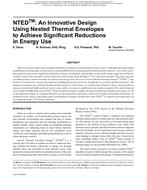Description
There is a need to reduce and eventually eliminate our reliance on nonrenewable energy sources. Although renewable energy technologies are promising, current sources cannot fulfill the increasing demands of industrialized countries. As a result, renewable solutions must involve significant reductions in energy consumption. A preliminary review of the energy supply mix in Ontario, Canada, reveals that renewable energy could meet home energy needs through a 75% reduction in demand. This paper presents a method of home construction that can achieve this energy goal. Known as Nested Thermal Envelope Design™ (NTED™), this method is an innovative concept that optimizes building heat gains and losses through the use of nested thermal envelopes. The design incorporates one insulated building inside another to control heat, air, and moisture transfer. A three-season perimeter area acts as a thermal buffer and heat recovery zone, while a core area is conditioned year-round as required. This study compares a low-energy R-2000 home to an NTED™ house located in Toronto, Canada. Research conducted to optimize the design as well as investigate the impact of occupant behavior on total energy use is presented. Study areas include (a) building orientation, (b)insulation levels, and (c) operating modes with building occupants. Results show that NTED™ is capable of meeting and even exceeding the target 75% energy reduction.
Citation: Thermal Performance, International Conference, 2010
Product Details
- Published:
- 2010
- File Size:
- 1 file , 1.5 MB
- Product Code(s):
- D-BUILDINGSXI-8




